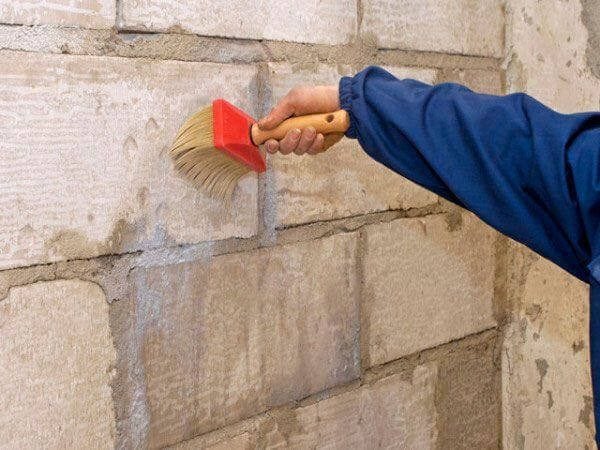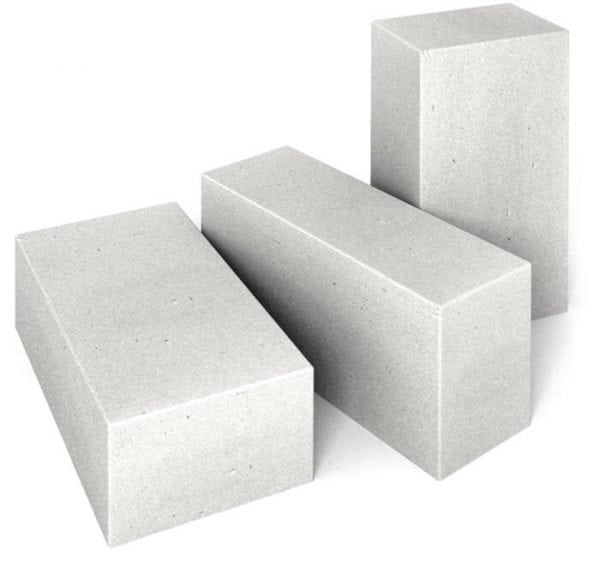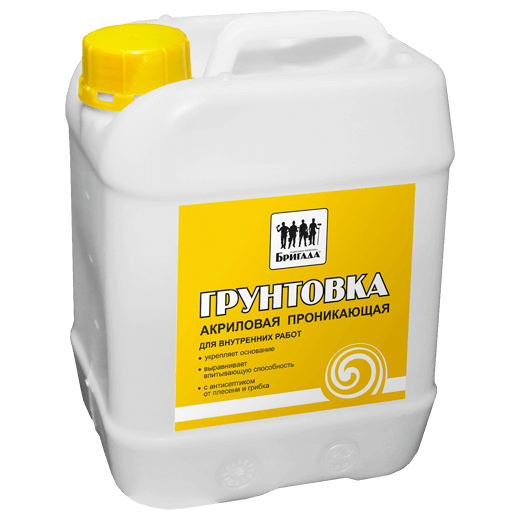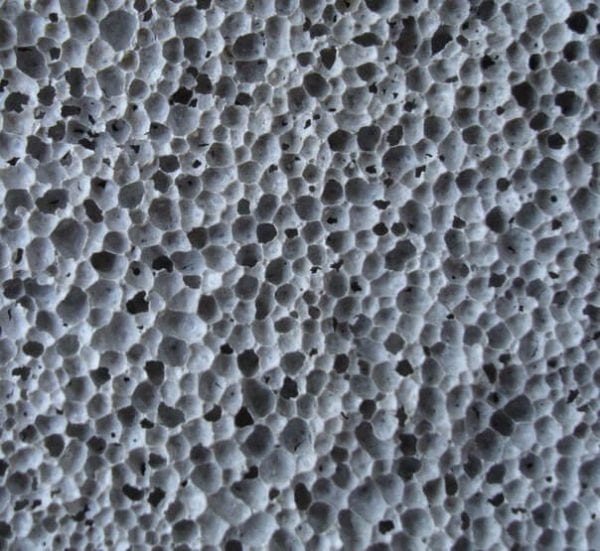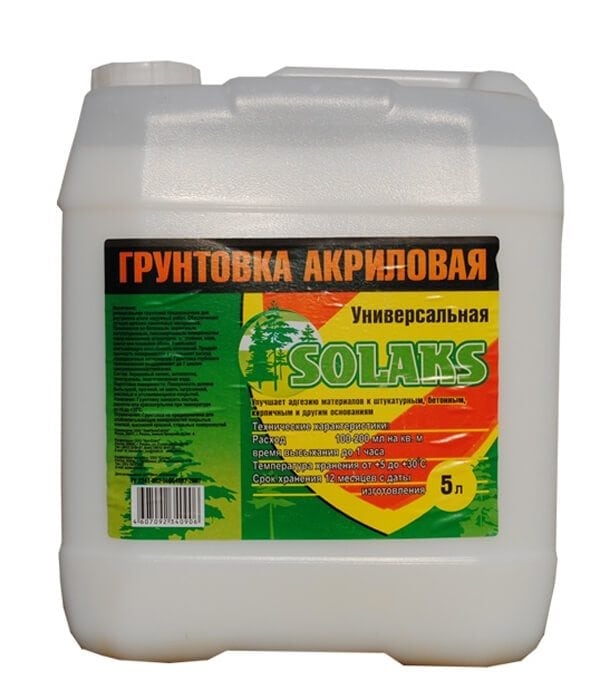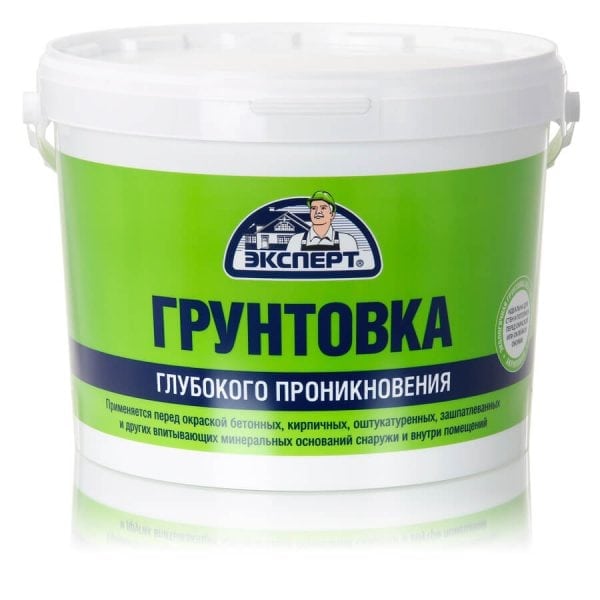Gas blocks and foam blocks are cheap and durable building materials, which are often used in individual housing construction. At the same time, the surfaces of any foam and gas silicate materials have insufficient presentation, are permeable and, in the absence of proper protection, quickly crumble, forming stable cold bridges. therefore primer is required before plastering for foam concrete and aerated concrete.
- The main functions of primers
- Surface preparation
- Primer mixture selection and application technology
- Limitations
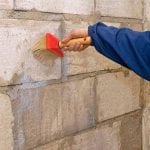
The main functions of primers
The primer performance of the internal and external surfaces of the foam or gas silicate blocks is determined by the following factors:
- The actual penetration depth of the primer in the thickness of the concrete block.
- The operating conditions of the products (temperature, relative humidity).
- Climatic indicators, in particular, temperature differences during the year.
- The nature of the subsequent finishing of the blocks (plaster, cladding, siding, tiles).
Based on the influence of these factors, the decisive factor is the ability of the primer to diffuse. Therefore, primers for primers for aerated concrete of deep penetration gain an advantage in priming porous surfaces.
The mechanism of action of primers for deep penetration is determined by two processes: the introduction of a primer into the deep layers of a foam block or gas silicate block and the formation of a surface moisture-resistant film. The result provides a number of undeniable advantages:
- The durability of internal structures formed from foam blocks increases, moreover, regardless of the initial humidity in the room.
- The process of plastering is facilitated, the consumption of plaster and paint is reduced. The composition and properties of the used plaster do not matter.
- The adhesion of the final coating increases, which improves the quality of the finish, whether it is laying tiles or wallpapering the walls.
- The antibacterial treatment of the walls is completely solved in order to prevent the appearance of fungus on them (especially in rooms with constantly high humidity).
to contents ↑Experts believe that the best result is achieved in situations where compositions of the same manufacturer are used for the primer and subsequent plastering. In this case, the best compatibility of the components of the substances is ensured.
Surface preparation
The core market does not suffer from a lack of appropriate offers. It is important to correctly determine the type of primer composition that would optimally meet exactly the user's conditions. The following are usually taken into account:
- for an internal primer - indicators of relative humidity;
- the method of subsequent surface treatment;
- the degree of porosity of the laid aerated concrete blocks;
- surface roughness of gas blocks;
- for an external primer - the temperature of the coldest and warmest periods of the year for a given area.
The influence of these indicators is manifested in the following. In conditions of high humidity, it is a primer with deep penetration that can create an effective layer of waterproofing, which subsequently prevents the passage of moisture into the material of the block. With increasing thickness of the primer layer, its operational durability increases. High-quality compounds, in addition, have increased elasticity, which is especially important with sudden changes in temperature.
Upon subsequent laying on the primed surface of the foam block of ceramic tile, the adhesion of the surface to the tile increases, while the consumption of adhesive composition, as well as the complexity of laying the tiles, are reduced.
Primer consumption depends on the degree of porosity and, consequently, the quality of the gas block. You can determine the quality factor of a product at home using two methods: assess the strength of the material and / or determine its actual density. Given that the acquisition of gas and foam blocks often comes from private manufacturers, the quality indicators of the source material are of great importance in the subsequent work with it.
To assess the strength, the finished block is laid on two steel channels, after which it is loaded in its middle zone (you can use a regular jack). The cracking pressure is used to judge the mechanical strength of the foam block. At a fracture stress of less than 1.3 MPa, the material is of poor quality and must be replaced. It is even easier to calculate the quality of the finished block by its water absorption, and this indicator is closely related to the density of the gas block.
The test is as follows. Before the test, the finished block is weighed, after which it is immersed in a container of water for 48 hours. After the specified period, the product is weighed, determining its weight gain due to the absorption of water by the material. With the increase in the difference between the two indicators, the quality of the gas block is worse.
In practice, it is advisable to be guided by the following ratios of the parameters of the operational strength of porous concrete.
| Density, kg / cm3 | Permissible compression stress, MPa, not less | Relative water absorption,% | Thermal conductivity coefficient W / m ° C, no more |
|---|---|---|---|
| 400 | 1,3 | 9,0 | 0,11 |
| 500 | 2,0 | 7,5 | 0,13 |
| 600 | 2,8 | 7,0 | 0,17 |
| 700 | 3,9 | 6,5 | 0,21 |
Blocks that do not show the above characteristics should not be used in individual construction. It is especially dangerous to prime low-quality foam and gas blocks on their external surfaces: the frost resistance of such products will be very low, and the primer will only accelerate the process of their destruction, since any external coating will increase the load on the walls of the house.
to contents ↑Primer mixture selection and application technology
Most often, when priming internal porous surfaces, primers based on acrylic compositions are used. They are quite versatile and contribute to the improvement of subsequent wall plastering.
However, the absorbency of acrylic primers is average. Therefore, to obtain the expected effect before priming, the surface must be thoroughly cleaned of traces of dirt, especially greasy. Sometimes, even before processing with a deep penetration primer, the blocks are even treated with an emery wheel, artificially increasing their roughness.
The positive features of the deep penetration acrylic primer are its environmental performance and moisture resistance. Therefore, such compositions are used mainly for bathrooms and kitchens.
It is recommended that antiseptic additives compatible with the chemical composition of the main composition be added to the composition of the acrylic primer before use.
Acrylic primer is applied in two layers.The first provides the penetration of the active substance into the pores of the blocks, contributing to an increase in their heat capacity and frost resistance, and the second (which is applied after the previous one has completely dried) provides improved adhesion of the block to tiles, paint, siding panels, wallpaper and other finishing materials. Acrylic compositions can be applied three times.
to contents ↑Limitations
The limitation of acrylic primers is that they practically do not change the vapor permeability of gas blocks. Meanwhile, low vapor permeability:
- over time, provokes peeling of wallpaper;
- degrades natural indoor air exchange;
- requires the installation of powerful systems of supply and exhaust ventilation.
Therefore, alkali metal silicates and latex additives are sometimes added to deep penetration acrylic primers. Such mixtures are more expensive, but provide the premises with the necessary performance indicators. When using dry mixtures, a similar effect can be achieved if diluted with water in high concentrations before use: not 1 to 4-5 (as recommended by the manufacturer), but in a ratio of 1: 1. The primer is more viscous, but it improves the vapor permeability of the finished porous surface.
The effectiveness of the deep penetration primer depends on the air temperature in the treated room. Acrylic compounds are not used in the winter season, as well as at outdoor temperatures of more than 30-35 ° C.
To apply a deep penetration primer, you can use both a paint roller and a mechanized spray gun. The primer penetrates well, not only into the base to be treated, but also inside the objects that are in the room. Therefore, before processing, they must be protected with plastic wrap.

